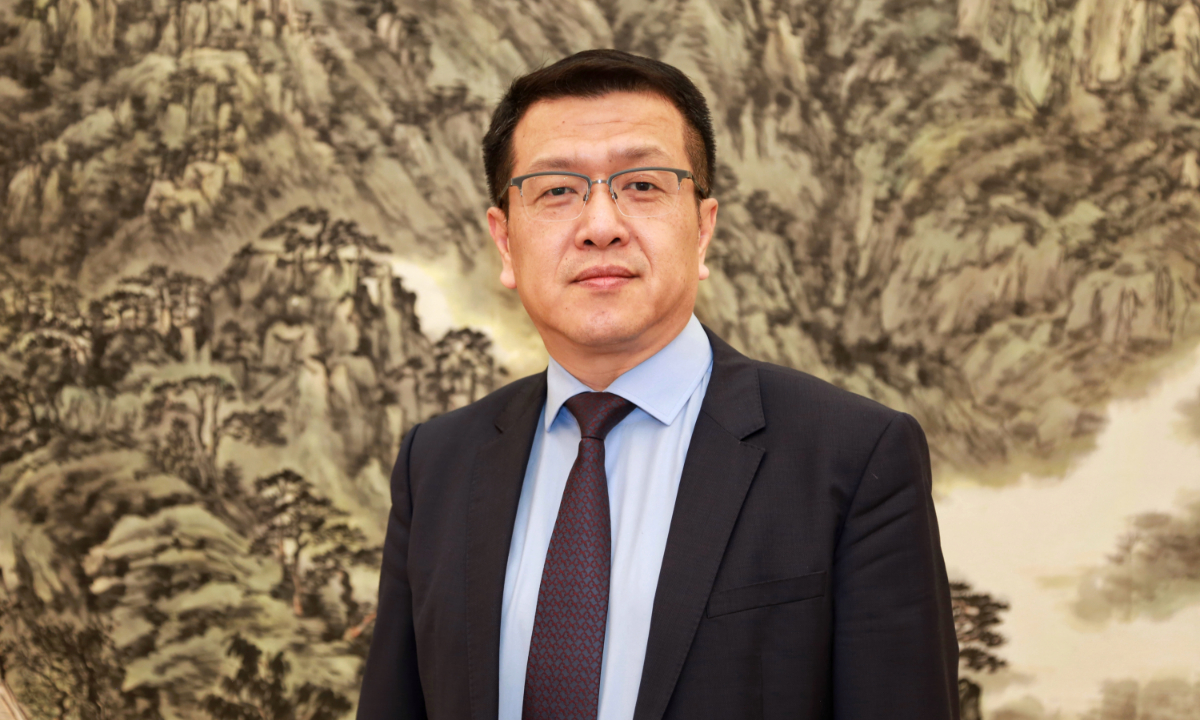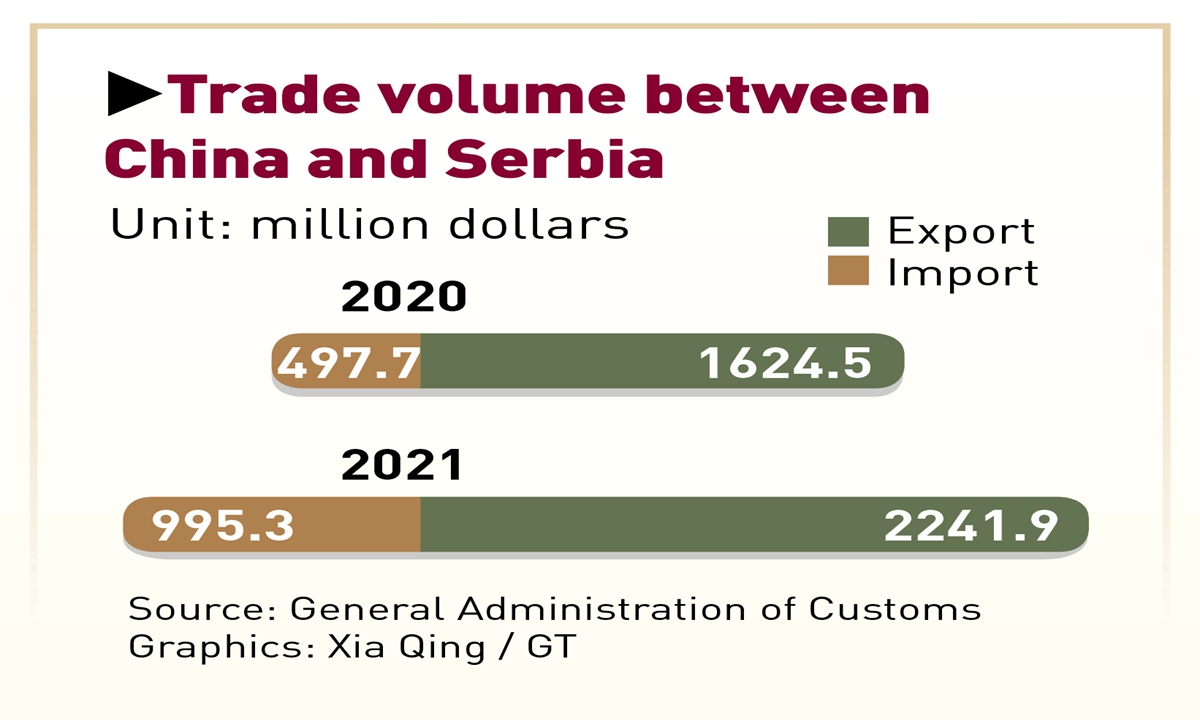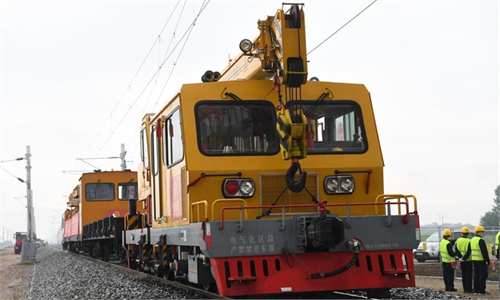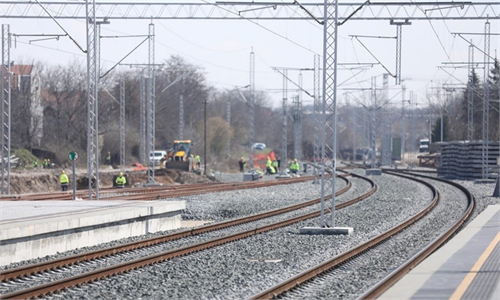China-Serbia Ironclad friendship sets a good example of China-CEEC cooperation amid world complex: Embassy

Editor's note:
China and Serbia are "iron brothers" and comprehensive strategic partners. As one of the first countries to sign a Memorandum of Understanding on Cooperation on the Belt and Road Initiative (BRI) with China, Serbia is also among the very first to benefit from the infrastructure partnership. From railways to telecommunications, the achievements of China-Serbia cooperation have continued to be a benchmark for success, bringing significant benefits to the two peoples and bilateral trade. While the external situation is becoming increasingly complex, on the basis of solid political mutual trust and public opinion, the bilateral relationship is only becoming more solid and sustainable. In an exclusive interview with the Global Times reporter Yin Yeping (GT) , Tian Yishu, Chargé d'Affaires of China's Embassy to Serbia addressed how the bilateral ties remain strong despite the complex global landscape.

Tian Yishu, Chargé d'Affaires of China’s Embassy to Serbia Photo: Courtesy of China's Embassy to Serbia
GT: Recently, the construction of the E763 Expressway Porega-Duga Polyana section project undertaken by China Road and Bridge Corporation of China Communications Construction Company has started. Can you briefly introduce the significance of this project to the overall bilateral cooperation?
Tian: The E763 highway Porega-Duga Polyana section is located in the central and southern Serbia, with a total length of about 73 kilometers. In the future, it can be extended to the south to connect the north-south expressway in Montenegro.
Located in a mountainous area, the project is the most difficult-to-construct section of the E763 expressway, 69.5 percent of which, about 50 kilometers, are composed of bridges and tunnels.
For decades, the one-way trip between the two places takes nearly three hours. After the project is completed, it is expected that the time will be greatly reduced to less than one hour. In the future, it will only take two hours to travel from Belgrade to Duga Polyana.
The project is of great significance to facilitating local people's lives, strengthening the connection between the north and the south while attracting more investment as well as promoting regional economic development.
President Vucic said that the project is a historic turning point in the development of the southern region of Serbia. The construction of this project by Chinese enterprises fully reflects the trust of the Serbian side in Chinese enterprises and Chinese technology. This project sustains the good momentum of bilateral cooperation in infrastructure construction and stands as another important outcome of the mutually beneficial cooperation between China and Serbia.
GT: On March 19, the Belgrade-Novi Sad section of the Belgrade-Budapest railway was opened to traffic. How do you evaluate the positive effect of this project on improving local people's livelihood and boosting the regional economy?
Tian: The successful opening of the Belgrade-Novi Sad section is a major progress in the construction of the Belgrade-Budapest railway. The Belgrade-Budapest railway connects Belgrade, the capital of Serbia, and Budapest, the capital of Hungary, with a total length of about 350 kilometers, including 183 kilometers in Serbia, and a design speed of 200 kilometers per hour.
The Belgrade-Novi Sad section is 80 kilometers long, shortening the travel time between the two largest cities of Serbia from 90 minutes to 30 minutes, which is of great significance to people's travel and the economic and social development along the route.
At the opening ceremony, Vucic said that the operation of this railway has realized the long-standing dream of the Serbian people.We are happy and proud to be able to help our Serbian friends realize this dream.
The new progress in the construction of the Belgrade-Budapest railway improves the passenger and freight transport capacity of regional railways, makes it convenient for people along the railway to travel, promotes the development of tourism and urbanization, facilitates the creation of a major trade corridor between China and Europe, and contributes to high-quality Belt and Road cooperation between China and Europe.

GT: Recently, a number of bilateral projects have begun to bear fruit. How do you view the progress of the Belt and Road projects in the country and its significance to bilateral relations?
Tian: Serbia firmly supports and actively participates in the BRI, and is one of the first Central and Eastern European countries to sign a Memorandum of Understanding (MOU) on Cooperation on the BRI with China.
Earlier participation brings about benefits earlier. In the past few years, through jointly building the Belt and Road, China and Serbia have made gratifying achievements in infrastructure, energy, investment and other fields. Serbia has been enjoying the sweet fruits of cooperation on BRI. Compared with other European countries, construction sites abound in Serbia, demonstrating a thriving development of the country.
Serbian people have witnessed the positive changes that have taken place in the country, and have truly felt the important opportunities brought by the BRI to Serbia's economic development.
In 2016, China's HBIS Group acquired the troubled Smederevo Steelworks, which not only saved the jobs of 5,000 workers, but also turned the century-old plant into profitable in less than a year, making it an important pillar of economic development again.
The joint construction of the Belt and Road by China and Serbia has brought tangible benefits to the two peoples. According to Serbia's statistics, the bilateral trade volume has tripled in just five years. In 2021, China has become its second largest trading partner, while HBIS Group Serbia and Serbia Zijin Copper continued to be the top two exporters in Serbia, helping both China and Serbia for a quick recovery after the epidemic.
The synergy between the BRI and Serbia's national development strategy has helped to scale new heights in China-Serbia comprehensive strategic partnership. In the future, the two sides will continue to forge high-quality Belt and Road cooperation so as to translate the traditional friendship between the two countries into more tangible results of practical cooperation, delivering more benefits to the two peoples.
GT: How do you see the prospects for China-Serbia cooperation, as well as the potential and challenges of bilateral cooperation in the future?
Tian: Under the strategic guidance of the two heads of state, the comprehensive strategic partnership between China and Serbia has reached an unprecedented high level. The bilateral cooperation has gradually expanded from infrastructure construction to various fields and yielded sound economic and social benefits, and will continue to widen and deepen.
China-Serbia relations have set a benchmark for mutually beneficial cooperation and served as a role model for jointly building the Belt and Road and for the cooperation between China and Central and Eastern European countries.
China-Serbia cooperation has broad prospects for development, as two sides are interested in further exploring cooperation in areas including green economy, clean energy, efficient energy use, internet plus, cross-border e-commerce, big data, cloud computing, smart city and 5G which will create new driving forces for China-Serbia bilateral cooperation and provide the two sides with greater impetus for sustainable development.
However, there are still challenges that both sides must encounter. One practical challenge facing bilateral cooperation is the epidemic, which to a certain extent has affected the progress of individual projects and face-to-face exchanges between the personnel of the two countries.
The second challenge is how to further strengthen the strategic alignment of the two sides and improve the quality and efficiency of bilateral cooperation to better serve the development needs of the two sides.
The third challenge is that a small number of people still do not want to see the development of China-Serbia relation, believing that it affects their interests in Serbia. But given the fact that the bilateral cooperation is based on mutual needs, which is in line with the willingness of the two peoples, I believe this factor will produce little impact on the bilateral ties.
Tian: The E763 highway Porega-Duga Polyana section is located in the central and southern Serbia, with a total length of about 73 kilometers. In the future, it can be extended to the south to connect the north-south expressway in Montenegro.
Located in a mountainous area, the project is the most difficult-to-construct section of the E763 expressway, 69.5 percent of which, about 50 kilometers, are composed of bridges and tunnels.
For decades, the one-way trip between the two places takes nearly three hours. After the project is completed, it is expected that the time will be greatly reduced to less than one hour. In the future, it will only take two hours to travel from Belgrade to Duga Polyana.
The project is of great significance to facilitating local people's lives, strengthening the connection between the north and the south while attracting more investment as well as promoting regional economic development.
President Vucic said that the project is a historic turning point in the development of the southern region of Serbia. The construction of this project by Chinese enterprises fully reflects the trust of the Serbian side in Chinese enterprises and Chinese technology. This project sustains the good momentum of bilateral cooperation in infrastructure construction and stands as another important outcome of the mutually beneficial cooperation between China and Serbia.
GT: On March 19, the Belgrade-Novi Sad section of the Belgrade-Budapest railway was opened to traffic. How do you evaluate the positive effect of this project on improving local people's livelihood and boosting the regional economy?
Tian: The successful opening of the Belgrade-Novi Sad section is a major progress in the construction of the Belgrade-Budapest railway. The Belgrade-Budapest railway connects Belgrade, the capital of Serbia, and Budapest, the capital of Hungary, with a total length of about 350 kilometers, including 183 kilometers in Serbia, and a design speed of 200 kilometers per hour.
The Belgrade-Novi Sad section is 80 kilometers long, shortening the travel time between the two largest cities of Serbia from 90 minutes to 30 minutes, which is of great significance to people's travel and the economic and social development along the route.
At the opening ceremony, Vucic said that the operation of this railway has realized the long-standing dream of the Serbian people.We are happy and proud to be able to help our Serbian friends realize this dream.
The new progress in the construction of the Belgrade-Budapest railway improves the passenger and freight transport capacity of regional railways, makes it convenient for people along the railway to travel, promotes the development of tourism and urbanization, facilitates the creation of a major trade corridor between China and Europe, and contributes to high-quality Belt and Road cooperation between China and Europe.

Belgrade-Novi Sad section of the Belgrade-Budapest railway kicks off operation on March 19, 2022. Photo: Xinhua
Tian: Serbia firmly supports and actively participates in the BRI, and is one of the first Central and Eastern European countries to sign a Memorandum of Understanding (MOU) on Cooperation on the BRI with China.
Earlier participation brings about benefits earlier. In the past few years, through jointly building the Belt and Road, China and Serbia have made gratifying achievements in infrastructure, energy, investment and other fields. Serbia has been enjoying the sweet fruits of cooperation on BRI. Compared with other European countries, construction sites abound in Serbia, demonstrating a thriving development of the country.
Serbian people have witnessed the positive changes that have taken place in the country, and have truly felt the important opportunities brought by the BRI to Serbia's economic development.
In 2016, China's HBIS Group acquired the troubled Smederevo Steelworks, which not only saved the jobs of 5,000 workers, but also turned the century-old plant into profitable in less than a year, making it an important pillar of economic development again.
The joint construction of the Belt and Road by China and Serbia has brought tangible benefits to the two peoples. According to Serbia's statistics, the bilateral trade volume has tripled in just five years. In 2021, China has become its second largest trading partner, while HBIS Group Serbia and Serbia Zijin Copper continued to be the top two exporters in Serbia, helping both China and Serbia for a quick recovery after the epidemic.
The synergy between the BRI and Serbia's national development strategy has helped to scale new heights in China-Serbia comprehensive strategic partnership. In the future, the two sides will continue to forge high-quality Belt and Road cooperation so as to translate the traditional friendship between the two countries into more tangible results of practical cooperation, delivering more benefits to the two peoples.
GT: How do you see the prospects for China-Serbia cooperation, as well as the potential and challenges of bilateral cooperation in the future?
Tian: Under the strategic guidance of the two heads of state, the comprehensive strategic partnership between China and Serbia has reached an unprecedented high level. The bilateral cooperation has gradually expanded from infrastructure construction to various fields and yielded sound economic and social benefits, and will continue to widen and deepen.
China-Serbia relations have set a benchmark for mutually beneficial cooperation and served as a role model for jointly building the Belt and Road and for the cooperation between China and Central and Eastern European countries.
China-Serbia cooperation has broad prospects for development, as two sides are interested in further exploring cooperation in areas including green economy, clean energy, efficient energy use, internet plus, cross-border e-commerce, big data, cloud computing, smart city and 5G which will create new driving forces for China-Serbia bilateral cooperation and provide the two sides with greater impetus for sustainable development.
However, there are still challenges that both sides must encounter. One practical challenge facing bilateral cooperation is the epidemic, which to a certain extent has affected the progress of individual projects and face-to-face exchanges between the personnel of the two countries.
The second challenge is how to further strengthen the strategic alignment of the two sides and improve the quality and efficiency of bilateral cooperation to better serve the development needs of the two sides.
The third challenge is that a small number of people still do not want to see the development of China-Serbia relation, believing that it affects their interests in Serbia. But given the fact that the bilateral cooperation is based on mutual needs, which is in line with the willingness of the two peoples, I believe this factor will produce little impact on the bilateral ties.

Trade volume between China and Serbia Graphic: Xia Qing/ GT
GT: Since last year, Lithuania has continued to unleash its hostile policy against China, unilaterally withdrawing from the "17+1" cooperation mechanism between China and Central and Eastern European countries, and constantly encouraging the EU to put pressure on China. In your opinion, is Lithuania disrupting China-CEEC cooperation? What is the current progress of China-CEEC economic and trade cooperation?Tian: Lithuania openly created the false impression of "one China, one Taiwan," undermining the "One China Principle", which has strained relations between China and Lithuania. It is not an issue between China and Central and Eastern European countries, but a bilateral issue between China and Lithuania.
The China-CEEC cooperation mechanism is a trans-regional mechanism established at the joint initiative of China and countries in central and eastern Europe. Adhering to the principle of voluntary consultation, joint contribution, openness and inclusiveness, it embodies our aspiration for win-win cooperation and shared development. Since its launch, China-CEEC cooperation has yielded fruitful outcomes and brought tangible benefits to the people of participating countries. It will not be affected by sporadic incidents.
The year 2022 marks the 10th anniversary of the establishment of the China-CEEC cooperation mechanism. Over the past decade, with the focus on practical cooperation, we have put in place a framework of cooperation led by the leaders summit and covers economy, trade, culture, education and other areas, ,making China-CEEC cooperation a model for trans-regional cooperation mechanism. In terms of economic and trade cooperation, we have so far built various new platforms including China-CEEC Expo, China-CEEC SME Cooperation Forum and financial companies and doubled our trade volume. China's investment in Central and Eastern European countries has increased by six times.
In 2021, the trade volume between China and the Central and Eastern European countries reached $133.55 billion, a year-on-year increase of 32 percent, which was 4.5 percent higher than the growth rate of China-EU trade in the same period. Going forward, China stands ready to continue sharing development opportunities and cooperation outcomes with relevant parties to realize steady and sustained growth of China-CEEC cooperation, and deliver greater benefits to the people.
GT: Since the escalation of the situation in Russia and Ukraine, the West has been increasing sanctions against Russia. Can you share with us the Serbian attitude toward Russia being sanctioned? Do you think the development of the situation in Russia and Ukraine will have an impact on China-Serbia cooperation?
Tian: Serbia has not joined the US and EU sanctions against Russia. The Serbian National Security Council pointed out in its conclusion on the situation in Russia and Ukraine that Serbia was subjected to severe sanctions by the West at the end of the 20th century, and Serbia believes that imposing sanctions on any country, its representatives or economic entities is not in line with its own economic and political interests.
All walks of life in Serbia are generally concerned that the current comprehensive and indiscriminate sanctions will trigger serious crises in global economy, trade, finance, energy, food, and industrial and supply chains, and the economic development of Serbia and people's lives will naturally be negatively affected.
The situation in Russia and Ukraine has had a huge impact on the global economy, and the relevant effects are now emerging. One direct result is the sharp fluctuation of raw material prices, which may have a certain impact on China-Serbia cooperation projects.
We will closely communicate and coordinate with the Serbian side and strive to minimize possible impacts so as to ensure the healthy and stable development of China-Serbia cooperation as well as its positive role in promoting the economic and social development of the two countries.



